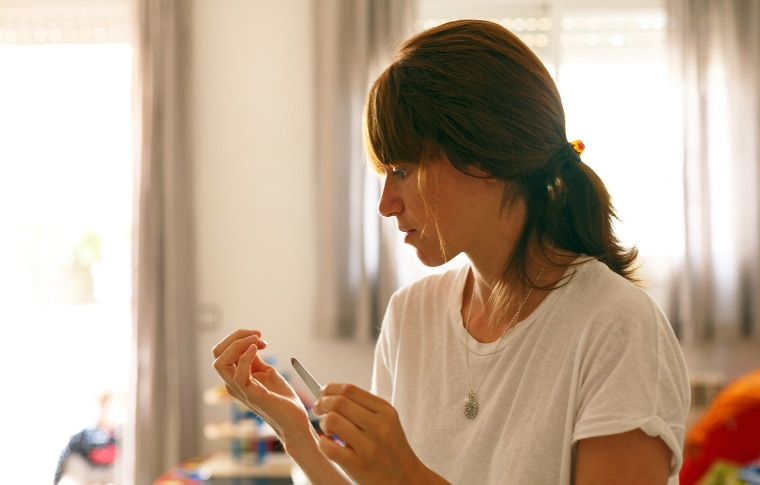As simple an issue as yellow nails may seem, it can be tough for even experts to pinpoint the cause.
"Every time somebody comes in with a nail change, I put on my super-sleuth hat," Dr. Kristen Lo Sicco, associate professor at the Ronald O. Perelman Department of Dermatology at NYU Grossman School of Medicine, tells TODAY.com.
The first thing to figure out is whether a patient's yellow nails may be due to some external factor causing staining or if they're a sign of an internal issue, like a nail infection, she says.
"You always want to rule out things that are on the outside and can be easily solved," agrees Dr. Shari Lipner, an associate professor of clinical dermatology at the Weill Cornell Medical Center. Common causes of yellow staining, like nail polish, food and smoking, are typically temporary and begin to correct themselves when that external factor is removed.
But infections and other health conditions that can cause yellow nails tend to cause other noticeable symptoms, like pain, nail thinning or thickening, and lifting of the nail, the experts say. And they won't go away on their own without treatment.
Figuring out what's causing your yellow nails — and the right way to treat them, might require a trip to the dermatologist. But, because yellow nails can be a sign of some serious issues and may require prescription treatment, it's worth the effort.

Common causes of yellow nails and how to treat them:
Yellow dyes and pigments
This one might seem obvious, but it's worth noting that people who work with yellow pigments — such as people who paint — may notice temporary staining on their nails, Lipner tells TODAY.com.
Treatment: When nails are stained, it's usually a temporary issue, Lo Sicco says. But, she adds, keep in mind that it typically takes six months for fingernails to completely grow out and 12 months for toenails. So it may take a while for the problem to completely correct itself.
“Sometimes using keratolytic creams that exfoliate, like a urea cream, can help,” Lo Sicco says. “But you want to be careful because you don’t want to thin out your nail too much,” she adds, noting that there isn’t much research on using these products, also sometimes called nail brighteners, to help with yellow nails.
Cooking with certain foods and spices
Figuring out what might be causing the issue often requires talking to the patient about their habits, such as what they've been cooking recently.
"Some things you cook with — like turmeric — I've seen turn patients' nails yellow," Lipner says.
Treatment: Again, staining like this is typically temporary and milder stains may start improving within days. Once you know which ingredients stained your nails, you can wear gloves next time you cook with them to avoid more staining, Lipner suggests.
Red nail polish
Experts don't totally understand why, but some red nail polishes can leave behind a yellow stain, Lo Sicco says.
"For some reason, using some of the red polishes for a longer period of time can cause staining," she explains. "Fortunately, when it's due to a polish, that's something that's reversible and not a permanent state."
Treatment: Nail polish remover is a good first step, Lipner says. And, in the future, using a base coat when painting your nails a reddish color can help prevent staining.
Smoking
"Smoking can tarnish the nails and cause yellow nails," Lo Sicco says. Research suggests this is due to the nicotine in cigarettes staining the nails and skin.
Treatment: While staining will generally go away over time, that's not necessarily the case if your yellow nails are due to smoking, Lo Sicco says. In this situation, the discoloration will continue as long as you keep smoking cigarettes. "That's yet another reason to stop smoking," she says.
Fungal infection
A fungal infection called onychomycosis is probably the most common cause of yellow nails that dermatologists see, Lipner says.
If your yellow nails are due to a fungal infection, you'll likely notice other changes to your nails, too, Lo Sicco explains. "Sometimes they can have a nail that lifts up off the nail bed or they might have an abnormal nail where it's flaky and brittle," she says.
But don't be surprised if your dermatologist takes a nail sample to confirm what's going on, the experts say. "If nail fungus is suspected, then taking a nail clipping and sending it for a culture is very standard practice," Lo Sicco explains.
"No doctor can make a diagnosis just by looking at your nails," Lipner agrees.
Treatment: You'll need to see your doctor or dermatologist to treat a fungal nail infection properly. And you will likely need prescription antifungal treatment.
Over-the-counter antifungal medications, like those meant to manage athlete’s foot, can help — to a degree. The fungus that causes athlete’s foot is usually the same one responsible for nail infections, Lipner says.
You can apply an over-the-counter antifungal to the feet and in between the toes to help tackle skin symptoms, but “it won’t work on the nails,” she says. “There’s no over-the-counter product that will treat the nails if you have a fungal infection.”
Nail psoriasis
The inflammatory condition psoriasis can affect the nails, Lipner explains. When psoriasis occurs on the skin, it can lead to changes in the nails as well, "but you can have nail psoriasis without having any skin (symptoms)," she says.
In people who just have nail psoriasis, the nails may be yellow, lifting from the nail bed and quite painful. You might also notice pitting (small notches) on the nails and nearby joint pain or arthritis, Lipner says.
Treatment: Nail psoriasis requires prescription medications, which can include a combination of corticosteroids, treatments derived from vitamin D treatments or vitamin A (retinoids), laser treatments and more, according to the American Academy of Dermatology.
Basic nail care strategies, like keeping your nails short and wearing gloves when doing housework, can help too, the AAD says.
Chronic paronychia
Paronychia refers to inflammation of the skin folds around the nail that's frequently due to injury or bacterial infection. When paronychia develops, "often you lose your cuticle, and the nail may turn to yellowish color," Lipner says.
This condition occurs more frequently in people who have jobs where they wash their hands often, including bakers and stay-at-home parents who may be washing a lot of bottles, she explains. It's also common among doctors, nurses and other medical staff who rinse their hands many times every day.
Treatment: Mild cases of paronychia may be managed at home, Cleveland Clinic says, with warm water soaks that help drain pus. But if your nail isn't getting better after a few days, or you find that you develop these issues frequently, you should talk to your doctor or dermatologist.
Prevention is key for chronic paronychia, Lipner says, and the most challenging part of that is avoiding irritants when washing your hands or doing dishes. "Every time you're washing dishes, you want to use gloves," she says. It's also important to keep your skin and nails moisturized, she adds.
Retronychia
This condition is a type of paronychia that generally occurs more often on the toenails than the fingernails, Lo Sicco says. “Not only can the nail become yellow in color, but it will stop growing,” she explains. From there, the nail might layer on top of itself and become ingrown.
Treatment: Retronychia is often due to repeated minor trauma, like wearing too-tight shoes that restrict the nail while jogging or playing sports, research suggests. So the first step is to correct the underlying trigger.
From there, early treatment might include corticosteroid medication, as well as taping and strategic clipping of the nail. In the later stages, though, studies suggest that surgical removal of the nail plate is an effective treatment. If you think you may have retronychia, it's important to get evaluated by a board-certified dermatologist to figure out the best course of treatment.
Traumatic onycholysis
If someone has onycholysis, that means the hard part of the nail plate is separating from the underlying nail bed, Lipner explains.
"We see this often in people who get frequent manicures and keep their nails long," she says. "And, because air gets trapped under the nail, they often have a yellow tinge to them."
Treatment: If your nail lifting is due to another condition, like a fungal infection, treating that will help correct the onycholysis.
For people with onycholysis due to trauma, "it helps to be gentle with the nails and keep them short," Lipner says. "If you are having manicures, all the filing should be gentle. Don't have anyone cut your cuticles. Don't push back your cuticles," she adds. "This all makes everything worse."
Yellow nail syndrome
Rarely, yellow nails can be due to a condition called yellow nail syndrome. "Literally all the nails turn yellow," Lipner says. "And once you see it, you just never forget it."
The nails may also be very curved and painful with a loss of cuticles. In people with yellow nail syndrome, the nails also tend to grow very slowly or not at all, Lipner says. "And typically all of your nails are involved," Lo Sicco says, not just one nail or a few.
Because yellow nail syndrome can be associated with lymphedema and lung issues, it's important to be aware of the signs and see a dermatologist quickly for an evaluation if you think you may have the condition, Lipner explains.
"Sometimes these yellow nails are the first indication that there's a systemic problem," she says.
Treatment: Managing yellow nail syndrome can include the use of corticosteroid medications, antibiotics and vitamin E supplements, the Cleveland Clinic says.
But because yellow nail syndrome may be connected to another underlying condition, your doctor will likely want to perform other diagnostic tests to see what's going on. If your yellow nail syndrome is fueled by another condition, they'll want to treat that condition, too.
When to see a doctor for yellow nails
The right way to treat yellow nails depends on what’s causing the issue for you. If you can identify an outside factor that may be responsible for your yellowing nails, like nail polish or food, then the yellow color is usually temporary.
For some issues, including those caused by fungal infections and psoriasis, you’ll likely need an evaluation from a dermatologist to figure out what steps to take.
If you’re dealing with other nail issues, like onycholysis or paronychia, your dermatologist will likely give you tips to care for your nails properly, Lipner says. They may suggest you keep your nails short, avoid cutting or pushing back your cuticles, being gentle during manicures and wearing gloves to protect them from soaps, detergents and water.
Within a few days, it will become more obvious whether or not you’re dealing with something you can manage at home, Lipner says. Over the course of a few months, you can keep an eye on new nail growth — and whether or not it's growing in yellow — for another clue about what might be going on, Lo Sicco says.
“But if something is persistent for months, it’s probably not going to get better,” Lipner says, “and it’s important to see a board-certified dermatologist.”









